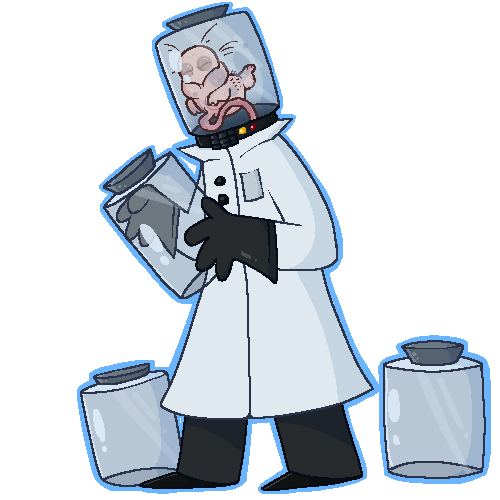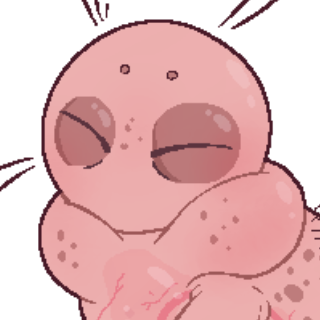[Cosmosdex] The Universal Encyclopedia
[Cosmosdex]
Blastebrus
Fetuses / Guy-In-A-Jar
Blastebrus

Art by, Flick
- Strength-2
- Intelligence-9
- Charisma-6
- Endurance-3
- Agility-3
- Luck-3
Common Jobs: Geneticist, Laboratory Worker, Host Designer
Likes: Warmth, Like-Minded Individuals, Cool Suits
Dislikes: Cold, Dry Conditions, Annoying Coworkers
Attack Method: A blastebrus in a suit will attempt to kick and punch, while one with a fauna host will use their host's claws and teeth to their advantage. However, a hostless blastebrus is as weak as an infant- the best they can do is give a light electric shock.
Attributes
Homeplanet: HevealusLifespan: 70 Years
Size: 1.5 ft tall
Diet: Host's Bloodstream, Nutrient Liquid
Bodytype: Xpod
Type: Symbotic Mammal
Social Class: Unknown
Rarity: Unknown
Common Traits
This character will commonly keep to themselves and gets a slight boost to production while doing so. When in a group this character will get a slight decrease to production.
This character is to the point with most things they say. Other characters appreciate this and do not lose sanity when speaking to this character no matter what is being spoken about, unless the other character has a trait that causes them to panic. Conversations with this character tend to be short.
This character is not known for their durability.
Gods
Blastebrus are not particularly religious- their once solitary lifestyle didn't lend well to the creation of religion.
Gods: None
Original Creator: Flick
Physical Description
Devoid of any form of suit or host, blastebrus are very simple creatures. They are small and nearly fetal in appearance, with stubby bodies and bulbous heads. Their large eyes are sealed shut, and they completely lack any form of mouth, nose, or ears. Blastebrus have a fatty dewlap around their neck, and their whole body is covered in translucent pink skin and sparse, bristly hairs. Blastebrus are capable of seeing through their translucent hide despite their eyes being sealed shut, and notably, a spiral-shaped intestine is visible through their skin. This intestine is often brightly-colored.
Blastebrus are also, notably, very underdeveloped. Their two arms are short and stubby, with small two-fingered hands, webbing between the digits. The single leg of the tripodal creature is almost tail-like, with 3 toes on the end of the paw. The leg of a blastebrus, which is otherwise useless, is full of electricity-producing cells that allow them to produce small, harmless shocks. Blastebrus also have what can only be described as an umbilical cord on their belly, with a tendril-covered end, rich with blood vessels that can attach to a host's bloodstream.
Blastebrus are brood parasites and internal parasites of mouthbrooding fauna native to their home planet. They lack any forms of dimorphism and can produce eggs on their own, as prior to modern days blastebrus were highly solitary. When their hosts go to nest, a blastebrus would slip a single egg inside the clutch of another nearby animal, temporarily leaving their host. The egg would then be cared for by their new host, hatching out and attaching its umbilical cord to the inside of the mouth or vocal sac. Modern blastebrus, however, typically incubate their eggs artificially, and stick their young into growing tanks until they're old enough to operate a suit.
Although fauna hosts for blastebrus can vary widely in appearence, most robotic suits follow the same basic structure- a fluid-filled jar where the blastebrus resides, a tube for the umbilical cord to be funneled through, an easily accessible chamber with a bag of nutrient liquid along with temperature, filtration and oxygenation regulation systems, and an outer chassis outfitted with a vocal synthesizer and limbs. Some suits are affixed with one or two artificial, screen-like fake eyes on their jar, to aid in body language. Blastebrus can control their suits using the electrical shocks they produce, and fauna hosts are controlled using a mix of chemicals, hormones and electrical shocks that blastebrus naturally produce. These control methods are entirely non-compatible with anything that isn't specifically made to work with a blastebrus's anatomy, or fauna from their home planet- blastebrus are only evolved to be able to effectively control the creatures they evolved alongside. Even the electrical shocks a blastebrus produces can be shrugged off by most species.
Personality
Blastebrus, despite their cute and simultaneously grotesque looks, are known to be somewhat grouchy. Only brought into a social lifestyle late into their evolution, blastebrus are still a solitary species at heart, often getting irritated when made to work in groups- at least with individuals who aren't similar in disposition to themselves. When respected and given much-needed space, a blastebrus can be quite pleasant to work with, ready to share and show off their latest plans for new suits and robots, or a brand-new faunal host for the more old-school folks. They can be rather polite when their boundaries are respected, and in fact tend to try and be as polite as they can manage, however, an irritated blastebrus won't hesitate to snap at coworkers and those who may have annoyed them.
Because of their once solitary lifestyle, blastebrus are not religious by nature- living inside a big animal's vocal sac your whole life all alone doesn't lend well to the creation of religions. Most, instead, dedicate their life to the sciences, especially the fields of genetics and robotics, as it allows them to directly work with the things blastebrus use to survive- modern, genetically-engineered fauna hosts, and artificial robotic suits. Capture creatures are especially beloved by blastebrus, as their inherent lack of the ability to feel pain both makes them ideal test subjects and an ideal base for an animal that's pretty much just going to be piloted around it's whole life.
History
Due to the fact that up until recently blastebrus spent their whole lives alone inside of an animal, very little is known about the history of their civilization, although some things can be inferred. Their population was heavily fragmented, and restricted to the coasts, where their hosts lived en masse. At this point, the species did have a simple civilization with agriculture, refined metals and tools, but it was simply to sustain their hosts, and their population density was incredibly low. This changed, however, when a blastebrus with a host that had dexterous limbs was able to, at some point, create the very first artificial suit, a technological feat that should've been nigh on impossible. With dexterous limbs, constant access to food, a safe environment and, notably, the ability to communicate with other members of their kind, blastebrus were able to rapidly expand into their currently technologically advanced society.
Much more is known about the evolution of the blastebrus, however. It was only a matter of time before the species pieced together how they got to here and now, and the evolution of the blastebrus is now a well-known and weird tale amongst their populace.
All vertebrate life on Hevealus's lands are tripods, descending from aquatic creatures with three limbs that crawled their way onto the muddy banks to take advantage of new ecological niches. These creatures rapidly diversified into a wide array of landbound beasts, many of which can be described as monotremes- warm-blooded and hairy creatures that lay eggs. Eventually, one branch of these egg-laying mammals dipped their toes back into the water, taking advantage of the untapped food sources beneath the waves. Some of these mammals eventually evolved into the direct ancestors of the modern blastebrus- large, round, hairy creatures with blunt snouts, small ears, big dewlaps, a taste for fish and an unrivaled curiosity.
At this point, these blastebrus ancestors could already be described as intelligent, although they were rather content with an animalistic lifestyle and didn't pursue civilization in the same way their descendants did. They took notice of how various species of local fauna would lay their eggs in nests along the coast, letting them incubate for a few days before taking all of the eggs into their mouth to incubate the rest of the way through, providing brief a window of opportunity for these ancient ancestors to slip some eggs into the nest and shrug off their parental duties onto the local animals. Naturally, these blastebrus ancestors took advantage of that.
Over time, it became advantageous for these ancient blastebrus to gain neotenic traits, like a blunter snout, less hair and shorter limbs, as it allowed them to be cared for longer by their fosters, the animals mistaking them for younglings for a longer period of time. This accumulation of neotenic traits continued to increase over time, until it was nigh on impossible for the blastebrus to survive without their foster parents- they retained their intelligence during this period as it was needed to outwit their hosts and trick them into continuing to provide care for the blastebrus.
Once this point was reached, it wasn't a huge step for them to begin directly parasitizing their hosts- they didn't need to be directly fed if they could simply absorb nutrients from the bloodstream of their foster parent. This, coincidentally, allowed the increase of neotenic traits to continue to flourish- you don't need a mouth, hair or developed limbs if all you do is sit inside the mouth of a mammal all day feeding from its bloodstream, so the blastebrus evolved to simply stop outwardly developing shortly after they hatched, leading to their modern fetal appearence. The umbilical cord of newly-hatched blastebrus was easily repurposed into a blood-vessel rich tendril that can burrow into the skin of their host and connect to their bloodstream.
Home Planet
Heveaulus is a planet with warm coasts and temperate, mountainous inland sections. A large majority of the planet is made up of ocean and brackish seaside beaches, with the overall landmass on its surface being relatively small compared to the amount of water. Hevealus is rather notable for two things- the rich amount of minerals such as iron in its crust, and the large amount of rubber-producing plants native to its more tropical coastal regions. Thanks to the warmth of the planet's coasts, small arthropods flourish, which can easily damage and eat away at plants, hence the evolution of thick, coagulating sap- rubber. These two factors are rather instrumental in the evolution of the blastebrus- rubber and metals are incredibly important components in the creation of robotic suits. In some areas of the planet, the soil is almost red with iron, and in the more mountainous regions it can take very little mining to actually unearth minerals of worth.
The planet, however, is rather notably lacking in many fossil fuels- although there were enough to get civilization off the ground, the limited supply necessitates trade with outside civilizations for continued expansion, invention and research. Hevealus didn't experience an extreme period of time where certain kinds of plant life weren't able to be broken down by decomposers, leading to relatively low amounts of coal and petroleum on the planet as a whole. The surface of the planet is dotted with factories and labs- it isn't uncommon to see faunal host creation companies setting up large reserves and labs to grow their populations of both test subjects and actual hosts, nor is it uncommon to see factories producing both refined materials and actual robotic suits.
Subspecies
Morphed Blastebrus: Morphed Blastebrus aren't what many would consider a true subspecies, but are instead a small subset of the population afflicted with odd mutations that allow the production of growth horomones vital for development of anything past the normally fetal looks of typical blastebrus. These blastebrus resemble what a blastebrus would look like if they properly developed and grew- something akin to their semi-aquatic ancestors, but still recognizable as a blastebrus. They're larger, with properly developed facial features such as a mouth, nose, and small ears. They have a full coat of fur and their limbs have properly developed digits- they still retain the electricity-producing cells in their leg. These blastebrus also have notably larger dewlaps and amounts of body fat, leading to a streamlined appearance in the water. Morphed blastebrus have rounder heads, larger eyes and smaller limbs compared to the fossils of their ancestors. Blastebrus can be forced to morph by consistently injecting these necessary growth hormones, however, morphing also drastically decreases the lifespan of a blastebrus from around seventy years to only around twenty- morphing takes a large toll on the blastebrus's body, and often causes health issues, mainly cardiac problems and issues with their bones and spine, which further adds to the decreased lifespan.
Special
None.
Trivia
• Despite misconceptions perpetuated by various media, blastebrus don't typically work with pyrotechnics or explosives. Their short fuse doesn't mean they work with things that have a fuse.
• Blastebrus can actually survive outside of a host for around a day or two as long as they stay moist and warm, however, they will be actively starving at any time past that, and typically won't survive any more than four days.
• Blastebrus are known to get along well with certain species more than others- they can bond with axeni over the mutual fact that they wear similar suits, and they work surprisingly well with more laid-back hirudinaria individuals.

